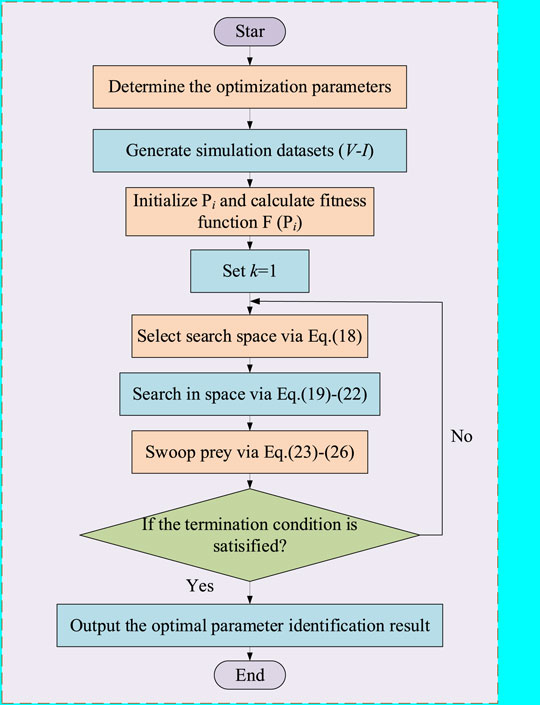- 1Key Laboratory of Modern Power System Simulation and Control and Renewable Energy Technology, Ministry of Education, Northeast Electric Power University, Jilin, China
- 2Faculty of Electric Power Engineering, Kunming University of Science and Technology, Kunming, China
A precise and reliable proton exchange membrane fuel cell (PEMFC) parameter identification performs an essential function in simulation analysis, optimal control, and performance research of actual PEMFC systems. Unfortunately, achieving an accurate, efficient, and stable parameter identification can sometimes be problematic for traditional optimization methods, owing to its strong coupling, inherent nonlinear, and multi-variable characteristics. Therefore, an advanced bald eagle search (BES) algorithm is designed to dependably identify the unknown parameters of the electrochemical PEMFC model in this work. For evaluating and analyzing the overall optimization performance of the BES comprehensively, it is compared with the genetic algorithm (GA) based on MATLAB under three cases. According to the simulation results, the optimum root mean square error (RMSE) achieved by BES is 96.27% less than that achieved by GA in parameter identification, which fully indicates that the precision, accuracy, and stability of the optimization results can be remarkably improved via the application of BES.
1 Introduction
Nowadays, in the context of the ever-increasing energy demand and dwindling fuel reserves (Sun et al., 2020; Liu et al., 2020; Noman et al., 2021), the transformation of traditional fossil energy (Iqbal et al., 2021; Bakeer et al., 2021; Erdiwansyah et al., 2021) and utilization of renewable energy have been brought to global researchers’ attention (Kalyan and Rao, 2021; Liu et al., 2021; Yang et al., 2020a). The exploitation of renewable energy (Zhang et al., 2019; Murty and Kumar, 2020; Zhang et al., 2021) has been proven as a significant measure for energy structure optimization (Huang et al., 2021; Liu et al., 2020; Chen et al., 2018), environmental governance, and ecologic protection (Yao et al., 2015). Meanwhile, proton exchange membrane fuel cell (PEMFC) (Ahmed et al., 2020) is born out as efficient alternative energy, in light of its ability to convert hydrogen (chemical energy) into electricity, with water as the sole by-product.
By virtue of the distinctive superiority of the low operating temperature, high power density, and easy maintenance, PEMFC has obtained a growingly widespread practice in multiple engineering fields, such as distributed generation, portable electronic applications, and transportation fields. For analyzing the characteristics of PEMFC with better accuracy and reliability, a variety of modeling techniques have been presented, such as isothermal one-dimensional mathematical model (Kalyan and Rao, 2021), mechanistic modeling (Liu et al., 2021; Giner et al., 2018), equivalent electrical circuit (Yang et al., 2020a), and steady-state electrochemical model (Zhang et al., 2019). In addition, the steady-state electrochemical model based on the electrochemical reaction mechanism can exceptionally demonstrate the voltage-current (V-I) characteristic under different operating conditions, in which some unknown yet significant parameters are required to estimate accurately and reliably.
Due to the highly nonlinear, multiply variable, and strong coupling characteristics of PEMFC, conventional deterministic optimization methods are restricted to obtaining satisfactory parameter identification results. Over the years, with the rapid advancement of emerging algorithm/soft computing, meta-heuristic algorithms with high adaptability and strong robustness have been universally applied in the field of nonlinear optimization systems. Hence, the parameter identification of PEMFC is achieved via various meta-heuristic algorithms. For instance, the genetic algorithm (GA) was adopted for fitting the Nexa 1.2kW PEMFC real data to obtain an exact identification of PEMFC parameters (Murty and Kumar, 2020). Zhang et al. (2021) applied grey wolf optimization (GWO) to achieve PEMFC parameter identification based on experimental data, which verifies the practicability of the proposed algorithm in simulating the electrical function of commercial PEMFC. Particle swarm optimization (PSO) is utilized to identify the off-line parameters of the Nexa 1.2kW PEMFC system at varying loads (Salim et al., 2015). Meanwhile, other excellent meta-heuristic algorithms were designed to be a useful tool to achieve optimal parameters, that is, artificial bee colony (ABC) (Liu et al., 2020), antlion optimization algorithm (ALO) (Chen et al., 2018), slap swarm optimizer (SSO) (Yao et al., 2015), flower pollination algorithm (FPA) (Ahmed et al., 2020), and improved version of monarch butterfly optimization (IMBO) (Giner-Sanz et al., 2018).
Many meta-heuristic algorithms with terrific effects are adopted to identify unknown parameters of PEMFC despite the complication of certain algorithms’ operation mechanisms and the ideal solutions, which are difficult to obtain with high precision and good stability. What is more, there are still many possibilities to attempt new ones. By simulating the actual operation of the cell in multi-functional environments, this work proposes bald eagle search optimization (BES) (Atlam and Dndar, 2021) to gain the optimum result of parameters in Amphlett’s model (PEMFC model) and tackle the aforementioned defects.
The main objectives and novelties of this study can be summarized as follows:
• A new optimization algorithm using BES is discussed for unknown parameter identification of the PEMFC electrochemical model;
• BES is a simple optimization technique, in which fewer parameters are required to be applied in the calculation process owing to the conciseness of its operation mechanism;
• Compared with GA, BES designed in this work presents a faster practical convergence speed in PEMFC parameters identification;
• Experimental results indicate that BES can efficiently identify parameters with fast convergence speed, high accuracy, and robustness owing to its strong ability to escape from the local optimum of Ballard-Mark-V PEMFC.
The rest of this article is organized as follows: the steady-state electrochemical model of PEMFC and objective function are described in Section 2. Besides, Section 3 thoroughly illustrates the execution mechanism and parameter identification of BES. Section 4 provides the simulation and analysis results in comprehensive cases. Lastly, Section 5 summarizes several conclusions along with future perspectives.
2 Proton Exchange Membrane Fuel Cell Modeling
2.1 Electrochemical Reaction Mechanism of Proton Exchange Membrane Fuel Cell
A typical PEMFC includes two electrodes (cathode and anode) and a proton exchange membrane (PEM), while electrodes are mainly composed of a gas diffusion layer and a platinum-based alloy catalyst layer. Hydrogen is decomposed into hydrogen ions H+ and electrons e− through catalytic reaction after passing through the anode catalytic layer. Subsequently, oxygen provided by the cathode catalytic layer integrates with electrons and hydrogen ions to generate water and heat. Figure 1 describes the structure of the reaction mechanism diagram, a single PEMFC, and a PEMFC stack of PEMFC. The electrochemical reaction mechanism in PEMFC is expressed as follows:
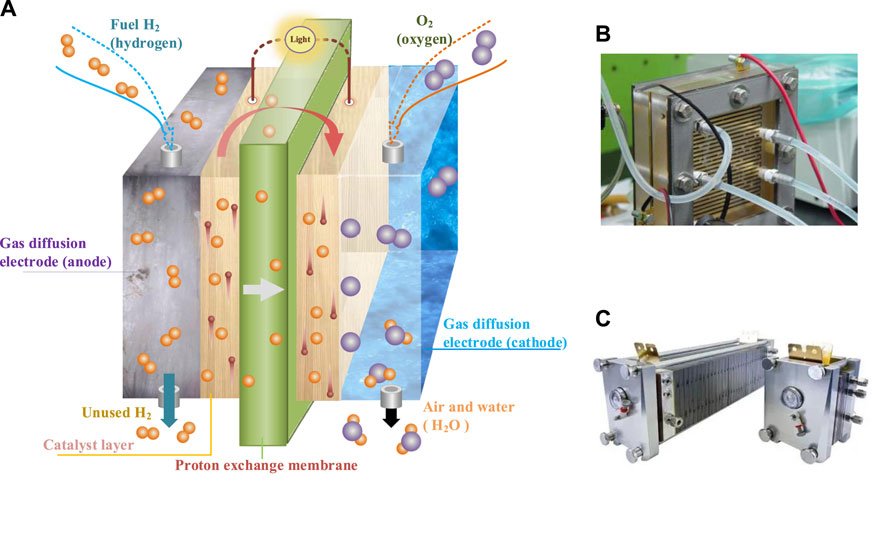
FIGURE 1. Structure of PEMFC. (A) Electrochemical mechanism of PEMFC; (B) single PEMFC, and (C) PEMFC stack.
At anode,
At cathode,
Overall chemical reaction,
2.2 Mathematical Modeling
The net output voltage of the electrochemical model is affected by three kinds of polarization, namely, activation, ohmic, and concentration polarization, while the voltage characteristic function of electrochemical can be written as (Amphlett et al., 1995)
where
In addition,
where
where RHa and RHc, respectively, denote the relative humidity of vapor at anode and cathode (atm); Pa and Pc are the inlet pressures of anode and cathode (atm), respectively; and
Moreover, the activation voltage
where
Ohmic voltage drop
where Rc is the equivalent contact resistance (Ω) and Rm represents the equivalent resistance provided to PEM conduction (Ω), which can be defined by
where l means the membrane thickness (
where
Furthermore, concentration voltage loss
where b means the parametric coefficient (V),
On the whole, after referring to the mentioned Eqs 4–15 for PEMFC, there are seven crucial parameters demand to be identified:
2.3 Objective Function
To precisely build a mathematical model of PEMFC based on the aforementioned unknown parameters, it is crucial to utilize an objective function to reliably evaluate parameter identification. In addition, the objection function based on the root mean square error (RMSE) can commendably mirror the deviation between the actual and estimated values.
Consequently, RMSE is accounted as the objective function given by
where N indicates the total quantity of actual datasets, Vactual is the actual voltage, and Vestimate denotes the estimated voltage.
Additionally, the restraints of crucial parameters can be written as
3 Bald Eagle Search Algorithm
3.1 Optimization Mechanism
The BES algorithm (Atlam and Dndar, 2021) is an innovative meta-heuristic algorithm enlightened by biological activities in nature. Individual search strategies can be established through their own mobile or global experience in the group random optimization process to optimize complex problems in the real world. In particular, the self-search and exploration of individuals in the search space are performed by simulating the predation behavior of bald eagles (e.g., prey on salmon living in a specific area). The bald eagles have a specific predation strategy, which can help them consume the least energy while maximizing the probability of predation success.
The bald eagle’s predation strategy has three major aspects: selecting the appropriate search domain, searching in the selected space, and the best chance to swoop on the prey.
In the select stage, the selected search space is related to the last movement of the bald eagle, which can be expressed as
where
After determining the search space, the bald eagle will search the space that flies spirally to search for prey and find the best-accelerated dive position. The change of the search position is expressed in polar coordinates as follows (Salim et al., 2015):
where
In the swooping stage, the bald eagle swoops to the prey at the optimal position, while other bald eagles in the population also move to the best position and dive down to attack the prey. The position updates during the swooping are expressed in polar coordinates as (Oliva et al., 2014)
where
3.2 Overall Optimization Procedure
On the basis of the BES algorithm, Figure 2 illustrates the flowchart of PEMFC overall parameter identification. Firstly, it is vital to determine which parameters in the steady-state electrochemical model are identified. After that, the output voltage and current data selected as the actual PEMFC will be regarded as the inputs of BES, while the data are transformed into the objective function according to Eq. 16. Furthermore, BES is employed to identify the parameters in accordance with the built model. Finally, the optimal parameter identification results of PEMFC are output after multiple iterations.
4 Case Studies
In this section, simulation experiments are performed on PEMFC under three different temperatures and relative humidity of vapor to identify seven crucial parameters (i.e.,
For a fair comparison between two meta-heuristic algorithms, each algorithm runs independently 10 times to obtain results, while their maximum iteration number is chosen as kmax = 500, and the population size is set to be identical psize = 40. The simulations are executed on MATLAB 2019b through a personal computer with IntelR CoreTM i5 CPU at 2.9 GHz and 16 GB of RAM.
4.1 Case 1 (Tk = 333.15K, RHa = 50%, and RHc = 50%)
When the experimental condition is set as Tk = 333.15K, RHa = 75%, and RHc = 75%, the simulation values of seven unknown parameters are generated by BES and GA algorithms. The satisfactory results of parameter identification and minimum RMSE of the PEMFC model are illustrated in Table 2. Particularly, RMSE acquired by BES is 94.11% lower than those acquired by GA, respectively. Hence, the advisable performance of BES is significantly greater than that of GA, which can be attributed to its consideration of accuracy, reliability, and high efficiency.
What is more, Figure 3A depicts the average RMSE acquired by the two algorithms under 10 independent runs. It is transparent that the accuracy of BES is significantly higher than that of GA, which fully demonstrates BES’s superior performance. Given that the average RMSEs of BES and GA algorithms hardly consist in the same order of magnitude, and the value of GA is about 12 times higher than that of BES, the BES’s effect of the actual data approximation is much better than GA.
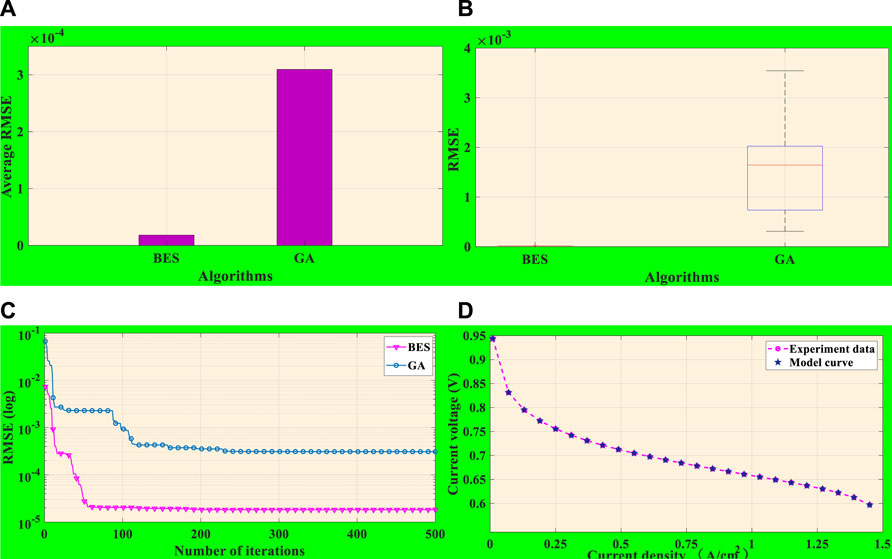
FIGURE 3. Comprehensive analysis of BES and GA under case 1. (A) Average RMSE. (B) Boxplot of RMSE. (C) Convergence curves. (D) Comparison of model datasets by BES with experiment datasets.
Figure 3B shows a boxplot of BES and GA, demonstrating the distribution range and upper/lower bounds of simulation explicitly and comprehensively. It can be seen from the chart that the error fluctuation interval and average RMSE of BES are far less than that of GA. Thus, the BES algorithm has accurate searching ability in PEMFC parameter identification and significant global searching ability.
Meanwhile, convergence graphs of the two algorithms are depicted in Figure 3C, while BES attains a stable optimal solution rapidly in approximately 60 iterations based on a global search.
As a single individual optimization and group cooperation mechanism, BES performs excellent local exploitation and global exploration, by which the accuracy and efficiency of parameter identification can be drastically improved.
Figure 3D describes the output V-I fitting curve on the basis of global optimal parameters identification by BES, upon which one can readily discover that the model curve achieved from BES approximates the experimental data to a great extent. It is undeniable that BES has superb performance in PEMFC parameter identification due to superior optimization ability and effectiveness.
4.2 Case 2 (Tk = 313.15K, RHa = 75%, and RHc = 75%)
When the simulation is in the condition of Tk = 313.15K, RHa = 75%, and RHc = 75%, the statistical results of seven unknown parameters and RMSE based on BES and GA are shown in Table 3. In particular, RMSE obtained by BES is significantly smaller than GA, while BES is 96.27% smaller than the RMSE of GA. Upon them, it is obvious that BES can considerably improve the accuracy of PEMFC model parameter identification.
Figure 4A presents the average RMSE obtained by BES and GA, illustrating that BES can acquire a lower average RMSE under 10 independent runs. Thus, BES has better accuracy and stability in the unknown parameter identification of PEMFC.
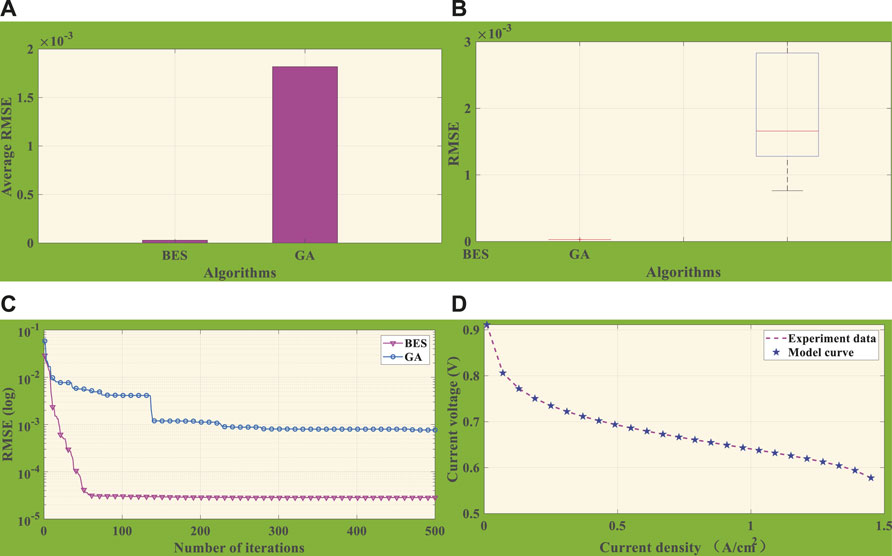
FIGURE 4. Comprehensive analysis of BES and GA under case 2. (A) Average RMSE. (B) Boxplot of RMSE. (C) Convergence curves. (D) Comparison of model datasets by BES with experiment datasets.
In addition, the RMSE boxplot obtained by BES and GA is depicted in Figure 4B, upon which the distribution range and upper/lower bound of BES are lower than those of GA. One can easily observe that the balance between global exploration and local exploitation of BES is better than that of GA.
In the meantime, convergence curves of BES and GA are shown in Figure 4C, where BES has about 55 iterations to achieve convergence, while GA needs 200 iterations to achieve convergence stability. Besides, RMSE after BES convergence is smaller than that of GA, while it can be perceived that BES identifies the unknown parameters of the PEMFC model with more accuracy and efficiency.
Figure 4D demonstrates the output V-I fitting curve obtained by the optimal results of BES, where data via BES are highly fitted with experiment data. The result efficiently reflects that BES has a superior ability for PEMFC parameter identification.
4.2 Case 3 (Tk = 353.15K, RHa = 50%, and RHc = 50%)
Table 4 illustrates the best PEMFC electrochemical model parameters and minimum RMSE under the condition of Tk = 353.15K, RHa = 50%, and RHc = 50% through BES and GA algorithm. In light of the result, BES represents the optimal performance owing that the minimum RMSE value acquired by BES is 46.13% lower than GA, which can accomplish parameter identification tasks in PEMFC with higher quality and accuracy.
The average RMSE obtained by BES and GA under 10 independent runs is shown in Figure 5A, while the value of the former is about one-quarter of the latter in the case of multiple operations, which is a lot smaller. Hence, BES outperforms GA in parameter identification and shows good stability and global optimization ability.
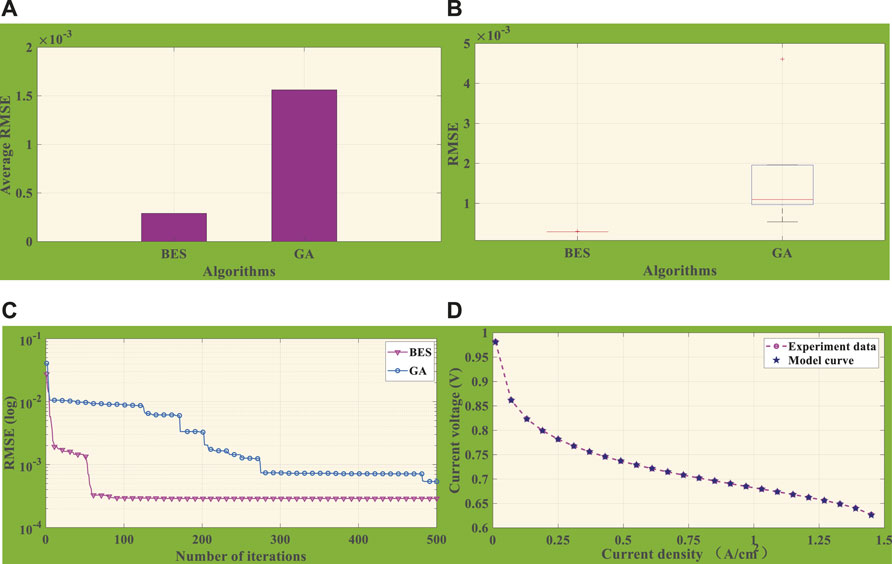
FIGURE 5. Comprehensive analysis of BES and GA under case 3. (A) Average RMSE. (B) Boxplot of RMSE. (C) Convergence curves. (D) Comparison of model datasets by BES with experiment datasets.
As is depicted in Figure 5B, it can be observed from the boxplot of BES and GA that the fluctuation range and average value of RMSE optimized by BES are lower than those of GA with 10 independent runs, which, from the perspective of either its stability or accuracy, effectively confirms the outstanding performance of BES in identifying the accuracy of PEMFC parameters. Moreover, Figure 5C presents the convergence curve of the two algorithms. BES converges at about 90 iterations, while GA does not reach a stable value until 480 iterations. After iterating 270 to 480 times, GA falls into a locally optimal solution and results in low efficiency and reduced accuracy. In general, BES is superior in convergence stability and precision for its exceptional global optimization ability.
In the end, Figure 5D describes convergence graphs of BES algorithms, which indicates that, in the case of parameter identification of BES, the experimental data and model fitting data are highly coincident, while the error is extremely small due to superior accuracy.
5 Conclusion
For the precise and reliable parameter identification of the PEMFC model, a meta-algorithm BES with superior performance is applied in this work, which includes three main contributions/novelties:
• BES is employed to obtain an accurate and credible parameter identification of PEMFC for the first time;
• In line with the simulation results, BES represents significant stability, faster convergence speed, and higher accuracy compared with the GA algorithm under two operation stations;
• Three common case studies (e.g., Tk = 333.15K, RHa = 50%, and RHc = 50%; Tk = 313.15K, RHa = 75%, and RHc = 75%; and Tk = 353.15K, RHa = 100%, and RHc = 100%) are emulated, which can validate that BES holds tremendous potential in PEMFC parameter identification, converging to the optimal stable solution rapidly because of the dynamic and proper balance between local exploitation and global exploration. Especially, the errors of BES convergence are significantly reduced by 94.11%, 96.27%, and 46.13%, respectively, in three cases of parameter identification compared with GA.
Future studies will be undertaken as follows:
• BES is proposed as a promising optimization method that remarkably improves the accuracy of the solution in PEMFC parameter identification. It also has the merits of universality and versatility in the meantime, contributing to the realization of parameter identification of more complex models or other FCs;
• In addition, it is worthwhile to perform online identification of PEMFC parameters, while the actual response speed and optimization capability of BES need to be further improved.
Data Availability Statement
The raw data supporting the conclusion of this article will be made available by the authors without undue reservation.
Author Contributions
BY: conceptualization, writing—reviewing and editing; DL: writing—original draft preparation, investigation; CZ: visualization and contribution to the topic discussion; YH: supervision. JL: performed visualization and validation.
Conflict of Interest
The authors declare that the research was conducted in the absence of any commercial or financial relationships that could be construed as a potential conflict of interest.
Publisher’s Note
All claims expressed in this article are solely those of the authors and do not necessarily represent those of their affiliated organizations or those of the publisher, the editors, and the reviewers. Any product that may be evaluated in this article, or claim that may be made by its manufacturer, is not guaranteed or endorsed by the publisher.
Acknowledgments
The authors gratefully acknowledge the support of the Opening Foundation of Key Laboratory of Modern Power System Simulation and Control and Renewable Energy Technology, Ministry of Education (Northeast Electric PowerUniversity, MPSS 2022-07).
References
Ahmed, K., Farrok, O., Rahman, M. M., Ali, M. S., Haque, M. M., and Azad, A. K. (2020). Proton Exchange Membrane Hydrogen Fuel Cell as the Grid Connected Power Generator. Energies 13 (24), 6679. doi:10.3390/en13246679
Ali, M., El-Hameed, M. A., and Farahat, M. A. (2017). Effective Parameters’ Identification for Polymer Electrolyte Membrane Fuel Cell Models Using Grey Wolf Optimizer. Renew. Energ. 111, 455–462. doi:10.1016/j.renene.2017.04.036
Alsattar, H. A., Zaidan, A. A., and Zaidan, B. B. (2020). Novel Meta-Heuristic Bald eagle Search Optimisation Algorithm. Artif. Intelligence Rev. 53, 2237–2264. doi:10.1007/s10462-019-09732-5
Amphlett, J. C., Baumert, R. M., Mann, R. F., Peppley, B. A., Rerge, P. R., and Harris, T. J. (1995). Performance Modeling of the Ballard Mark IV Solid Polymer Electrolyte Fuel Cell. J. Electrochem. Soc. 142 (1), 9–15. doi:10.1149/1.2043959
Angayarkanni, S. A., Sivakumar, R., and Ramana Rao, Y. V. (2020). Hybrid Grey Wolf: Bald eagle Search Optimized Support Vector Regression for Traffic Flow Forecasting. J. Ambient Intelligence Humanized Comput. 12 (1), 1293–1304. doi:10.1007/s12652-020-02182-w
Ariza, H., Correcher, A., Sánchez, C., Pérez-Navarro, Á., and García, E. (2018). Thermal and Electrical Parameter Identification of a Proton Exchange Membrane Fuel Cell Using Genetic Algorithm. Energies 11 (8), 2099. doi:10.3390/en11082099
Atlam, Z., and Dndar, G. (2021). A Practical Equivalent Electrical Circuit Model for Proton Exchange Membrane Fuel Cell (PEMFC) Systems. Int. J. Hydrogen Energ. 46, 13230–13239. doi:10.1016/j.ijhydene.2021.01.108
Bakeer, A., Salama, H. S., and Vokony, I. (2021). Integration of PV System with SMES Based on Model Predictive Control for Utility Grid Reliability Improvement. Prot. Control. Mod. Power Syst. 6, 14. doi:10.1186/s41601-021-00191-1
Bao, S., Ebadi, A., Toughani, M., Dalle, J., and Yldzbas, A. (2020). A New Method for Optimal Parameters Identification of a PEMFC Using an Improved Version of Monarch Butterfly Optimization Algorithm. Int. J. Hydrogen Energ. 45, 17882–17892. doi:10.1016/j.ijhydene.2020.04.256
Chen, J., Yao, W., Zhang, C., Ren, Y., and Jiang, L. (2018). Design of Robust MPPT Controller for Grid-Connected PMSG-Based Wind Turbine via Perturbation Observation Based Nonlinear Adaptive Control. Renew. Energ. 101, 34–51. doi:10.1016/j.renene.2018.11.048
Erdiwansyah, , Mahidin, , Husin, H., Zaki, M., and Muhibbuddin, (2021). A Critical Review of the Integration of Renewable Energy Sources with Various Technologies. Prot. Control. Mod. Power Syst. 6, 3. doi:10.1186/s41601-021-00181-3
Giner-Sanz, J. J., Ortega, E. M., and Herranz, V. P. (2018). Mechanistic Equivalent Circuit Modelling of a Commercial Polymer Electrolyte Membrane Fuel Cell. J. Power Sourc. 379, 328–337. doi:10.1016/j.jpowsour.2018.01.066
Huang, S., Wu, Q., Liao, W., Wu, G., Li, X., and Wei, J. (2021). Adaptive Droop-Based Hierarchical Optimal Voltage Control Scheme for Vsc-Hvdc Connected Offshore Wind Farm. IEEE Trans. Ind. Inform. 17 (12), 8165–8176. doi:10.1109/tii.2021.3065375
Ijaodola, O. S., El-Hassan, Z., Ogungbemi, E., Khatib, F. N., Wilberforce, T., Thompson, J., et al. (2019). Energy Efficiency Improvements by Investigating the Water Flooding Management on Proton Exchange Membrane Fuel Cell (PEMFC). Energy 179, 246–269. doi:10.1016/j.energy.2019.04.074
Iqbal, B., Nasir, A., and Murtaza, A. F. (2021). Stochastic Maximum Power point Tracking of Photovoltaic Energy System under Partial Shading Conditions. Prot. Control. Mod. Power Syst. 6, 30. doi:10.1186/s41601-021-00208-9
Isa, Z. M., Nayan, N. M., Arshad, M. H., and Kajaan, N. A. M. (2019). Optimizing PEMFC Model Parameters Using Ant Lion Optimizer and Dragonfly Algorithm: A Comparative Study. Int. J. Electr. Comput. Eng. 9 (6), 5295. doi:10.11591/ijece.v9i6.pp5295-5303
Kalyan, C. H. N. S., and Rao, G. S. (2021). Impact of Communication Time Delays on Combined LFC and AVR of a Multi-Area Hybrid System with IPFC-RFBs Coordinated Control Strategy. Prot. Control. Mod. Power Syst. 7, 185. doi:10.1186/s41601-021-00185-z
Liu, J., Yao, W., Wen, J., Fang, J., Jiang, L., He, H., et al. (2020). Impact of Power Grid Strength and PLL Parameters on Stability of Grid-Connected DFIG Wind Farm. IEEE Trans. Sustain. Energ. 11 (1), 545–557. doi:10.1109/tste.2019.2897596
Liu, S., Zhou, C., and Guo, H. (2021). Operational Optimization of a Building-Level Integrated Energy System Considering Additional Potential Benefits of Energy Storage. Prot. Control. Mod. Power Syst. 4, 184. doi:10.1186/s41601-021-00184-0
Murty, V. V. S. N., and Kumar, A. (2020). Multi-objective Energy Management in Microgrids with Hybrid Energy Sources and Battery Energy Storage Systems. Prot. Control. Mod. Power Syst. 5 (1), 1–20. doi:10.1186/s41601-019-0147-z
Noman, M., Li, G., and Wang, K. (2021). Electrical Control Strategy for an Ocean Energy Conversion System. Prot. Control. Mod. Power Syst. 6, 12. doi:10.1186/s41601-021-00186-y
Oliva, D., Cuevas, E., and Pajares, G. (2014). Parameter Identification of Solar Cells Using Artificial Bee colony Optimization. Energy 72, 93–102. doi:10.1016/j.energy.2014.05.011
Priya, K., and Rajasekar, N. (2019). Application of Flower Pollination Algorithm for Enhanced Proton Exchange Membrane Fuel Cell Modeling. Int. J. Hydrogen Energ. 44 (33), 18438–18449. doi:10.1016/j.ijhydene.2019.05.022
Salim, R., Nabag, M., Noura, H., and Fardoun, A. (2015). The Parameter Identification of the Nexa 1.2 kW PEMFC’s Model Using Particle Swarm Optimization. Renew. Energ. 82, 26–34. doi:10.1016/j.renene.2014.10.012
Sayed, G. I., Soliman, M. M., and Hassanien, A. E. (2021). A Novel Melanoma Prediction Model for Imbalanced Data Using Optimized SqueezeNet by Bald eagle Search Optimization. Comput. Biol. Med. 136, 104712. doi:10.1016/j.compbiomed.2021.104712
Sun, K., Yao, W., Fang, J., Ai, X., Wen, J., and Cheng, S. (2020). Impedance Modeling and Stability Analysis of Grid-Connected DFIG-Based Wind Farm with a VSC-HVDC. IEEE J. Emerg. Sel. Top. Power Electron. 8 (2), 1375–1390. doi:10.1109/jestpe.2019.2901747
Yang, B., Li, D. Y., Zeng, C. Y., Chen, Y. J., Guo, Z. X., Wang, J. B., et al. (2021). Parameter Extraction of PEMFC via Bayesian Regularization Neural Network Based Meta-Heuristic Algorithms. Energy 228, 120592. doi:10.1016/j.energy.2021.120592
Yang, B., Wang, J. B., Yu, L., Shu, H. C., Yu, T., Zhang, X. S., et al. (2020). A Critical Survey on Proton Exchange Membrane Fuel Cell Parameter Estimation Using Meta-Heuristic Algorithms. J. Clean. Prod. 265, 121660. doi:10.1016/j.jclepro.2020.121660
Yang, B., Wang, J. B., Zhang, X. S., Yu, T., Yao, W., Shu, H. C., et al. (2020). Comprehensive Overview of Meta-Heuristic Algorithm Applications on PV Cell Parameter Identification. Energ. Convers. Manag. 208, 112595. doi:10.1016/j.enconman.2020.112595
Yang, B., Zeng, C. Y., Wang, L., Guo, Y., Chen, G. H., Guo, Z. X., et al. (2021). Parameter Identification of Proton Exchange Membrane Fuel Cell via Levenberg-Marquardt Backpropagation Algorithm. Int. J. Hydrogen Energ. 46 (44), 22998–23012. doi:10.1016/j.ijhydene.2021.04.130
Yao, W., Jiang, L., Wen, J., Wu, Q., and Cheng, S. (2015). Wide-area Damping Controller for Power System Interarea Oscillations: A Networked Predictive Control Approach. IEEE Trans. Control. Syst. Tech. 23 (1), 27–36. doi:10.1109/tcst.2014.2311852
Zhang, H. X., Lu, Z. X., Hu, W., Wang, Y. T., Dong, L., and Zhang, J. T. (2019). Coordinated Optimal Operation of Hydro-Wind-Solar Integrated Systems. Appl. Energ. 242, 883–896. doi:10.1016/j.apenergy.2019.03.064
Zhang, K., Zhou, B., Or, S. W., Li, C., Chung, C. Y., and Voropai, N. I. (2021). Optimal Coordinated Control of Multi-Renewable-To-Hydrogen Production System for Hydrogen Fueling Stations. IEEE Trans. Industry Appl. doi:10.1109/TIA.2021.3093841
Glossary
ABC artificial bee colony
ALO antlion optimization algorithm
BES bald eagle search
FC fuel cell
FPA flower pollination algorithm
GA genetic algorithm
GWO grey wolf optimization
PEMFC proton exchange membrane fuel cell
PEM proton exchange membrane
SSO slap swarm optimizer
b parametric coefficient, V
l membrane thickness,
R parameter that controls the search period, between 0.2 and 2
Keywords: proton exchange membrane fuel cell, parameter identification, bald eagle search algorithm, metaheuristic algorithm, MATLAB
Citation: Yang B, Li D, Zeng C, Han Y and Li J (2022) Bald Eagle Search Algorithm for Parameter Identification of Proton Exchange Membrane Fuel Cell. Front. Energy Res. 10:885461. doi: 10.3389/fenrg.2022.885461
Received: 28 February 2022; Accepted: 24 March 2022;
Published: 25 April 2022.
Edited by:
Siqi Bu, Hong Kong Polytechnic University, Hong Kong SAR, ChinaReviewed by:
Xingshuo Li, Nanjing Normal University, ChinaYiyan Sang, Shanghai University of Electric Power, China
Copyright © 2022 Yang, Li, Zeng, Han and Li. This is an open-access article distributed under the terms of the Creative Commons Attribution License (CC BY). The use, distribution or reproduction in other forums is permitted, provided the original author(s) and the copyright owner(s) are credited and that the original publication in this journal is cited, in accordance with accepted academic practice. No use, distribution or reproduction is permitted which does not comply with these terms.
*Correspondence: Yiming Han, MzczNDgyNzUzQHFxLmNvbQ==
 Bo Yang
Bo Yang Danyang Li2
Danyang Li2 Yiming Han
Yiming Han Junhui Li
Junhui Li